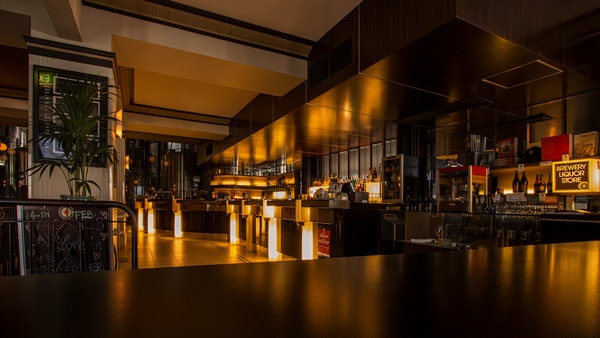Lighting a restaurant correctly is not a simple task. Lighting must be in line with the style of the restaurant and the type of dishes served, but it must also facilitate the work of cooks, waiters, etc.
When defining what type of lights to use, what power or color temperature, we have to differentiate the areas and activities that take place in each one.

Regulations for restaurant lighting
Within the European Standard UNE 12464-1, restaurants are in the section of places of public concurrence in the same heading as hotels.
Four areas are differentiated: the hall, the cashier’s office, the kitchen and the restaurant room itself. In this case, minimum illuminance levels are defined for all of them except for the dining area. Here it is only indicated that the light must be sufficient to create the right atmosphere.
Entrance and bar area
A minimum of 100 lux with a glare ratio (UGR) of 22 or less is required. The illuminance should go up to 300 lux where the cash register is located and where the waiters work.
Kitchen
About 500 lux is needed here and cool lights are recommended. This type of light increases concentration and visibility, improving work performance and safety. It is advisable to have an area with a transition light to avoid glare and to allow the eyes to better adapt to possible differences in light with respect to the room.

Dining room or living room
In this case we have complete freedom to design the lighting to suit the image of the business. In any case, the light must allow the circulation of workers and customers without danger. At the tables, the ideal is that the light is at least sufficient to see what is being eaten.
LED lighting in the hospitality industry
LED technology is an important leap in the way bars and restaurants are illuminated. Not only does it allow us to have lighting fixtures with designs that were impossible until now, but it also means the possibility of significantly reducing the costs associated with maintenance and electricity consumption.
LED lights are very efficient and consume up to 90% less than their halogen equivalents. On the other hand, they are much more durable.
Decorating restaurants with light
In many cases, the current trend is to use lighting as a decorative element of the space. In this way, light helps to create the right atmosphere for diners to feel at ease.
Our aim is to achieve coherence between lighting, furniture, wall finishes, etc.

Fundamental elements for lighting a restaurant
There are a multitude of LED luminaires to choose from, just take a look around our online store and see the many options we have available. Below we will introduce some of the main ones.
Downlights
A classic of general lighting. They allow to illuminate very uniformly the space. They are the best option for the kitchen and any other area where we need the light to be, so to speak, abundant. The smaller models and with smaller opening angle allow us to create very cozy environments.
Track lighting
Although traditionally used in store lighting, this type of lighting is very useful in restaurants and bars.
It is based on electrified rails on which are installed different spotlights that can be moved along the same. This provides great versatility since we can adapt the arrangement of the luminaires if there are, for example, changes in the distribution of the tables.
Pendant lamps
Pendant lamps are also widely used, especially over tables. Normally a warm light temperature and a medium-low luminosity are used so that it is not annoying.
Strips and neons
Both LED strips and neons are often used as accent lighting, especially in the bar area or underneath shelves.
In the end, the lighting of a restaurant is the piece that gives personality to the premises and must be in line with the decoration and the gastronomic proposal offered.

